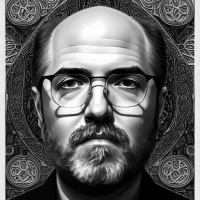Children of the Fleet Continues the Ender’s Game Tradition
Orson Scott Card’s first solo Ender novel in nearly a decade banks on nostalgia in its return to a repurposed Battle School.
For those of us who enjoyed Ender’s Game in our youth, Orson Scott Card’s latest entry into that universe, Children of the Fleet, which hits the market on October 10, 2017, is a long-awaited sequel in a way that Speaker for the Dead and Xenocide never really could be. The joys of battle school, color coded armies, whip-smart kids, and rites of passage are what make the original novel so compelling, and while Card’s new novel is not exactly inhabiting the same world Andrew Wiggin left, the spirit of the story remains intact.
Children of the Fleet tells the story of Dabeet Ochoa, a highly intelligent but somewhat arrogant young lad of 11 years who desperately wants to transcend the stifling confines of his gifted school in Indiana for the glories of Fleet School, the new name for Battle School where the International Fleet trained its soldiers in Ender’s time. These days, the station situated at the L5 Lagrange point is where the future leaders of colonies are trained to navigate the difficulties of life on the barely habitable planets left behind in the wake of the Formic Wars.
While that might not sound as exciting as teaching battle strategy with zero-g maneuvers in the game that dominated life in Ender’s time, the book acknowledges the difference by making the war games less important for the social status of the children themselves. Instead, the “armies” are now “teams,” emphasizing how different life would be for children being trained more as administrators and managers than soldiers and generals. The hierarchy within the team is now based on parental history in the Formic Wars rather than army standings.
Dabeet’s own parentage is somewhat in question, especially since having a family member in the Fleet is a prerequisite for admittance into Fleet School. Interestingly, Dabeet doubts his own mother’s story of his important father who was supposedly in the Fleet but who, by all indications, was a fiction invented by his mother to maintain status in her own community. The truth of the matter as it unfolds is one of the more compelling aspects of Dabeet’s story, and it informs many of the decisions that are made around him.
The political situation that appeared in the Bean-centric “Shadow Series” is also present here, providing the motivation for the antagonists in Children of the Fleet. Representatives of countries that are fighting for autonomy as Peter Wiggin and Julian “Bean” Delphiki work on forming the planet-wide hegemony involve themselves in Dabeet’s life in surprising ways, and the central conflict revolves around Dabeet working to overcome his self-centered mindset to bring his schoolmates together against an enemy that would see Fleet School fall.
Fans of the games in the battle room will enjoy the new twists that Card has in store as Dabeet, who is completely unskilled in zero-g maneuvers, figures out inventive ways to assist his team. The actual battles with other teams are disappointingly understated, but the strategy involved still excites the imagination and appeals to the reader’s sense of nostalgia for Ender’s frozen leg shields and other innovations in the battle room.
One familiar character, now aged, that appears in this novel is school administrator Hyrum Graff, who takes an interest in Dabeet and opens his eyes to how meaningless his excellent test scores are. While some of the verbal interplay between the great minds can be a bit heavy at times, especially in the opening chapters, it sets the stage for Dabeet’s evolution from a self-important loner to a grateful friend to those who take most of the book to warm up to him.
While reading Children of the Fleet, there’s definitely the sense that you can never really go back to Battle School. Everything is covered in a thin layer of dust, including the battles themselves, the interactions between children on the station, and even the somewhat disconnected motivations of the enemy. There are some wonderful moments of tension as the children work against incredible odds in the hidden recesses of the station, and the references to the legacy of Ender and Bean are great for those who have read Card’s earlier novels; however, it’s still but a shadow of the original.
Children of the Fleet is a worthy successor to the world of Ender’s Game and provides a glimpse of what Andrew Wiggin left behind when he began his journey towards becoming a speaker for the dead. Dabeet is an appropriately complex protagonist inhabiting a slightly muted but no less familiar world, and his transformation during the course of the novel is enjoyable to behold. Fans will enjoy returning to Card’s land of child prodigies, a character type the author knows so well, and will perhaps look forward to more tales of the colonization of the galaxy through Dabeet’s eyes.
Children of the Fleet goes on sale on October 10, 2017.
